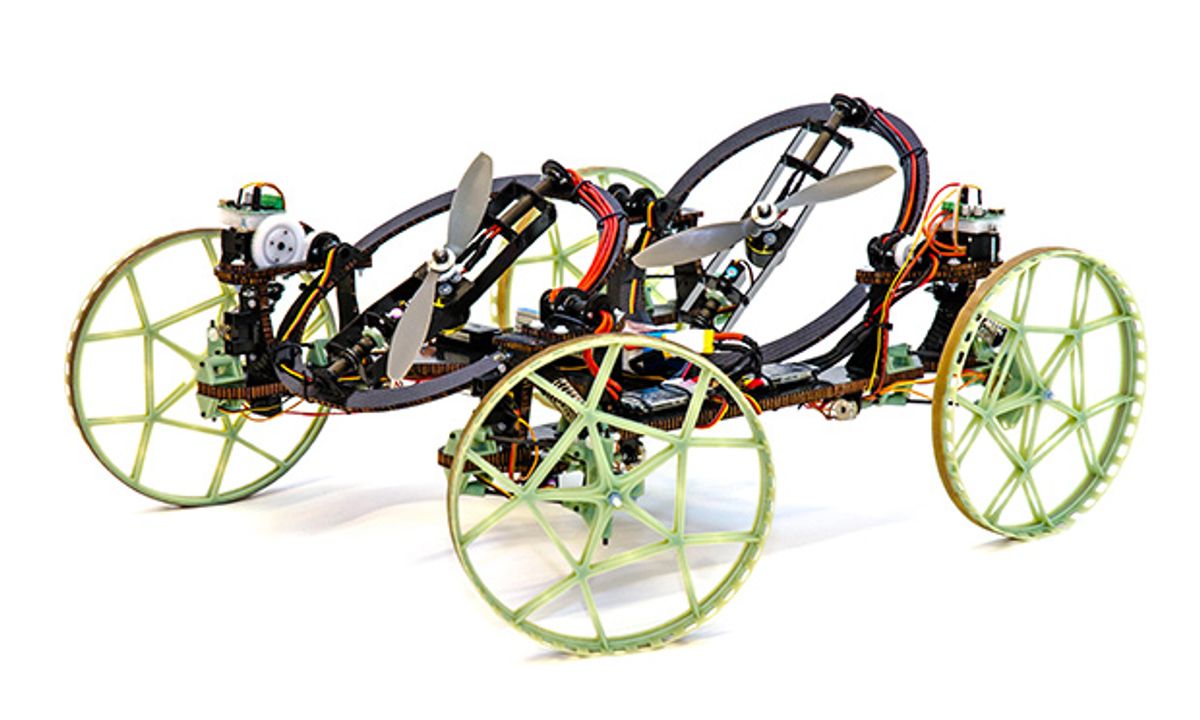For robots, multimodal is the way to go, when going involves getting to as many places as you possibly can. Designing a robot with the ability to deal with a variety of terrains or conditions usually requires some creativity, and in the past, some of the most creative designs have come from ETH Zurich and Disney Research, like this wall-climbing base-jumping tornado-powered robot called Paraswift.
As cool as Paraswift was, since it depended on suction to climb walls, it couldn’t deal with rough surfaces that prevented a solid vacuum seal. This led the Disney Research/ETH team to try something else, and that something else is a new robot called VertiGo, which is a sort of hybrid helicopter-car-thing that can drive on the ground and then transition to climb up vertical walls.
A key research problem in the design of VertiGo robot was to maximize the ratio between thrust output and vehicle weight. Weight is minimized by using a central carbon fibre baseplate, while 3Dprinted parts in conjunction with carbon-rods are used for more complex three dimensional structures like the wheel suspension or the wheels themselves. The baseplate provides mounting points for two thruster modules and the wheel suspensions. It also serves as carrier for all the electronic parts and wires. The thrusters are mounted using a two-ringed Cardan Suspension. Integrated servomotors allow the inner and outer ring to be moved independently from one another. This supports the generation of all the forces required to drive on the floor, on walls and theoretically even on the ceiling.
Those four wheels are unpowered: all of VertiGo’s propulsive power comes from those two steerable propellers, which can direct thrust along both pitch and roll axes. It’s no slouch in car mode, but the neatest trick is of course the ground to wall transition, which the robot accomplishes by using its rear propellor to thrust against the wall while the front propellor thrusts upward, causing the robot to flip vertically. This particular control problem was “somewhat of a step in the dark,” Disney Research’s Paul Beardsley told us. “But it worked.”
The advantage that VertiGo has over climbing robots that rely on adhesion is that VertiGo is actively pushing itself onto the wall, which means that it doesn’t care all that much about the characteristics of the wall itself. It’ll work on smooth surfaces like glass, masonry like brick, rough surfaces like trees, and even surfaces that are curved. VertiGo also has a big advantage over flying robots: it’s much safer. The worst thing that can happen to VertiGo is that it falls off of whatever wall it’s climbing up, whereas a quadrotor could just decide to take off into the wild blue yonder. As long as nobody stands directly underneath VertiGo while it’s climbing, safety concerns are minimal.
As with any of the robots that come out of Disney Research, we of course had to try and figure out what kinds of Disney-ish things might be in store for them, and we got a little bit of an answer from Paul Beardsley:
“About why Disney is interested in this area, I am not able to say specifics as you can understand. But just speaking in general, one can imagine that robots with lighting effects could be useful for entertainment effects or for wall games. This also relates to the question of why the ground-wall transition is useful. If you have to manually place a robot on a wall at the start of a deployment, and manually remove it at the end, then that's taking manpower and it's not flexible. If the robot can make those transitions automatically, then you are a step in the direction of autonomous deployment, and that makes the technology more powerful. We are motivated by making a practical device, so it is real-world feedback and challenges that drive our work.”
Hmm, interesting. We certainly have seen several examples of research from Disney (or in collaboration with Disney) related to swarms of robots of various sizes that can create lighting displays, including Pixelbots and Display Swarm. So yes, we could totally imagine some VertiGo robots with lights on them zipping around floors and walls. And it would make for a pretty awesome toy, although we wouldn’t want to get our hopes up about that.
[ VertiGo ] via [ Disney Research ]
Special thanks to Dr. Paul Beardsley for speaking with us
Evan Ackerman is a senior editor at IEEE Spectrum. Since 2007, he has written over 6,000 articles on robotics and technology. He has a degree in Martian geology and is excellent at playing bagpipes.





